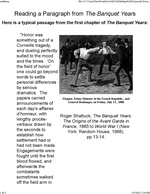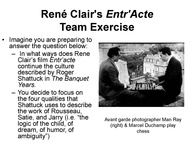(This page was originally designed to accompany an article that is being considered for publication (" Focused and Holistic Decoding: Two Ways to Embody Modeling, Practice, and Assessment"), but this material may be, of interest to a wide-range of those working within Decoding.
The material below was drawn from an upper level history course and was designed to help students work through a series of connected bottlenecks, all of which can prevent a student from successfully writing a history paper.
Bottlenecks
Here are the bottlenecks that are being worked on. In writing a history paper students frequently have difficulty:
- Understanding that history is about presenting interpretations and supporting them with evidence
- Understand what needs to be demonstrated to support a particular interpretation
- Reading selectively looking for relevant evidence to support a particular interpretation
- Explaining to a reader how the evidence supports this interpretation
Holistic Decoding
In developing strategies for modeling, providing practice and feedback, and assessing student progress in reference to these four bottlenecks, I deviated from the common practice of using Decoding as an intervention in an existing course in order to help more students get past specific obstacles before returning to the course as it was previously constituted -- a process I have characterized as "Focused Decoding." Instead, in the course under consideration I made the overcoming of these bottlenecks a central focus of the course itself, privileging modeling, practice, assessment over sharing content and disciplinary concepts. I also treated modeling, practice, and assessment, not as steps in a sequential process, but rather as functions several of which could be actualized in a single activity. Thus, a particular online assignment, an in-class team exercise, or a background lecture might be designed so that they fulfilled one, two, or even all three of these functions.
The goal of this approach, which I have called "Holistic Decoding," is to embed the students in a learning environment in which call of the elements work together to reinforce what students need to learn to do to get past the bottlenecks listed above.
Activities
Below is a list of the activities I used in the first two weeks of the course to create an environment in which appropriate elements of building a history paper was modeled, practiced, and assessed in an organic fashion. When appropriate, I have added links to course materials that were actually used in the process and indicated which of three Decoding functions was being addressed. But the real impact lies less in any single activity, but rather in the cumulative impact of them in creating an organic learning experience.
- Week 1 mini lecture: Goal = reading selectively and dealing with material that is unfamiliar.
- I read a passage from the main reading assignment for the week and systematically demonstrated how I would isolate the elements that were relevant to this course (Modeling) --
- Week 1 online modeling presentation: Goal = reading selectively and dealing with material that is unfamiliar.
- On the course website students were presented with a different passage from the readings and given pointers on how to identify material that was relevant to their work for the week. (Modeling) Reading The Banquet Years -- 1
- Week 1 & 2: Goal = 1) helping students to recognize that history is about presenting and offering evidence to support interpretations; 2) showing students how to connect interpretations with specific evidence
- Mini lectures were presented in the form of competing interpretations of the issues at hand, and relevant background information was introduced as evidence supporting one interpretation or another. (Modeling and Practice) Modeling the Writing of a History Paper
- The second week’s online assignment presented students with two interpretations of the relationship between Avant Garde culture and bourgeois capitalist society. The students chose one of these, selected four bits of relevant evidence, and then explained how this example made the interpretation that they had chosen more credible. (The structure of the assignment required them to find evidence in two different sections of the assigned readings, on the course website, and from one of the lectures — thus, also also modeling the integration of multiple sources, and an incentive to do the readings and follow the lectures.) (Week 2 Assignment)
- Week 2 Team Exercise #2 Students viewed René Clair’s short film, Entr’acte and then considered how individual elements in the film might provide support for an interpretation of modernism that they had encountered in the readings. (Wk2B Team Exercise)
- In between these activities there were whole-class discussions in which teams reported out and the basic pattern of focusing on evidence and interpretations was reinforced once again.
See also
- Decoding work on history

